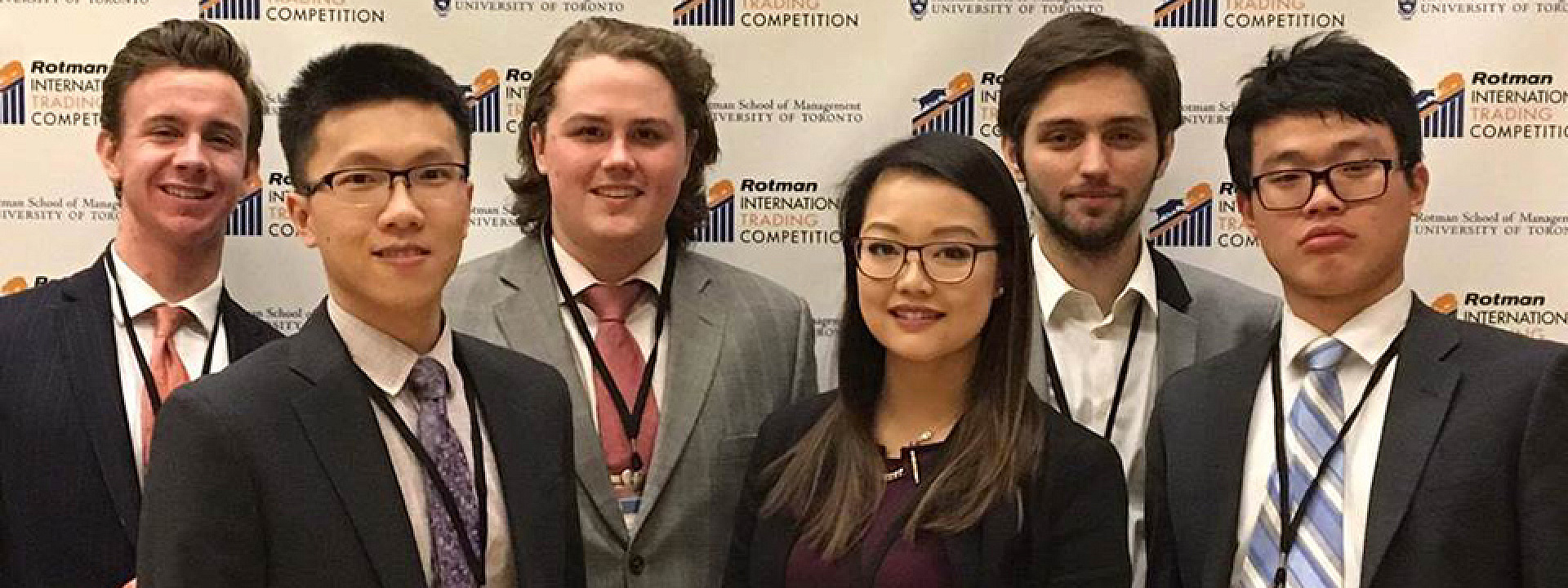The University of Toronto’s Rotman International Trading Competition (RITC), brings together some of the world's top business schools for a 3 day intensive simulation. Out of the 52 attending schools, The University of Ottawa’s Telfer School of Management performed exceptionally and emerged 13th. Telfer surpassed competition from schools such as McGill, Pennsylvania State University, Columbia, University of Chicago, Western, Queens, The Shanghai Advanced Institute of Finance and University of Hong Kong.
This year’s team consisted of six of our highest-performing finance students: Evan Friend, Danika Fu, Jack Lau, Dmitry Shorikov, William Tu, and Patrick Winogron, and was coached by Pouya Safi, the Manager of the Financial Research and Learning Lab. The team was formed following their exceptional performance at the Telfer Trading Competition in October. Since then, the team had been meeting regularly to devise their strategies and practice on the RIT software. Anyone passing by the Financial Research and Learning Lab was likely to have seen these students preparing for the competition. The preparation only became more intense as the competition approached. By the time reading week had started, RITC team members could be found practicing round the clock, often spending more than 12 straight hours in the lab. Even on the train ride to Toronto, the team continued to fine-tune their strategies.
The events opened with a welcome ceremony and introduction to the event. There was also a social outcry round for competitors to practice outcry strategy, and Jack Lau placed 2nd in this event!
This year, the competition was broken down into six official events focusing on options, sales & trading, commodities, fixed income, algorithmic trading and quantitative outcry. The competition was largely made up of graduate students in programs such as finance, mathematics, financial engineering and quantitative financial modeling.
First among the events was the BP Commodities case. Here, team members were assigned roles as traders, producers or refiners. The team had to work together to interpret market signals and trade various petroleum commodities and futures contracts. This was an extremely strong case for the Telfer team, placing 6th in this event.
In the options case, teams had to analyze market data to trade different call options on a fictitious exchange-traded fund. Competitors devised a model that collected, interpreted and modeled this data and devised a strategy to successfully trade on this model’s data. The final strategy combined volatility measures, delta hedging and pricing arbitrage to result in a 6th place finish.
With two sixth place finishes on the first day, the Telfer team occupied 6th place going into day two. Day two included cases such as credit risk, algorithmic trading, sales & trading and quantitative outcry.
The S&P Global Credit Risk case involved pricing corporate fixed income products, and calculating their risks. Tools such as implied price difference, and Altman Z-scores were used to help predict the price path and if the company would default on their debt. After extremely high hopes for the case, Telfer was ranked in the top 20.
The sales and trading case, sponsored by Flow Traders, was another great event for the Telfer team, finising in 14th place. The case required participants to take on the role of a trader and make rapid evaluations of liquidity risk. Throughout the case, the traders had to assess the value and risk level of dozens of tender offers and execute trades on the positions gained through these tender offers. Success was determined by the team’s ability to manage its market exposure while exploiting market-making opportunities.
The Algorithmic Trading case, in which the Telfer team finished in the top 25, focused on the development of a trading algorithm that would analyze market data and trade on that data, all while avoiding market penalties. Requiring a tremendous amount of preparation, this case was carried out by a single team member, Dmitry Shorikov, sequestered in a closed room.
The most exciting competition was the Quantitative Outcry Case. This involved two team members acting as market analysts and incorporating market data into a model of numerous countries’ GDP in order to price a market index. This estimate was then transmitted via silent hand signals to two other team members working in an open-outcry trading pit. These players, dressed in bright costumes to make themselves more visible to the analysts, bought and sold based on the analysts’ instructions.
In the past four years of attending, it was clear that this was one of the most determined and prepared teams the Telfer School has ever sent. The team improved on the previous year's result, and considering all of the preparation and practice prior to the competition, it is easy to understand why. The RITC team had been meeting every Saturday since November practicing and creating strategies. The students returning to school next semester are already eager to improve on their excellent performance this year, and those graduating are wishing for one more chance. A special thanks goes to Mr. Pouya Safi, the Telfer Marketing Department, CETSC, and the Telfer Career Centre for their help in funding the expenses of attending the competition.
Every year, the team is looking to acquire new talent, and will be prospecting at the Telfer Trading Competition in October 2017. If you are interested in investing, trading, financial modeling or would just like to get more involved, do not hesitate to try out. The team encourages any interested students to try out or contact them for any information.
Highlighted Results:
- Overall Ranking: 13th
- Social Outcry: 2nd Place – Jack Lau
- Commodities: 6th Place
- Options Case: 6th Place



